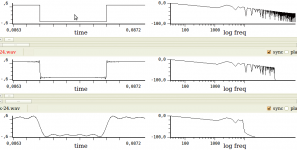oon_the_kid said:
The issue here is, it would not be possible to model a perfectly random signal. Hence the proponents would say the didgital filter is flawed to begin with.
Oon
Your arguments are flawed. Saa7220 ??
Look. During production of music , they use all kinds of digital filters, upsampling(!!!) , because analog gear emulations only work on heavily upsampled signals , then they decimate it as well, after "dialing" the desired nonlinearity....
OFcouse they put digital processing into DA chips sparingly. But, in 2009 we have ultra high end chips like ESS32 , thats not exactly an easy thing to surpass in software realm either , let alone dsp... You really should leave this TDA craze behind (that was bad idea to begin with ) and look around.....
I always wonder about the square wave vs. preringing/postringing argument. Most debaters probably do not realize that the reason they see square in their wave-generation SW is due to flawed drawing algorithms which dumbly connect samples with straight lines (the same holds for the "linear interpolation" DAC)instead of properly upsampling to individual pixels of their screen resolution. Then they would see the same "pre/post-ringing" instead of the "nice" squares. Which is correct for the bandwidth-limited system.
phofman,
I was waiting for this.
Please explain in detail, why a correctly working bandwith limited DAC that switches BPZ +fs -fs BPZ or -fs +fs -fs +fs should have pre-ringing in your opinion.
So you say that reconstruction with a analog filter is wrong because it lacks the pre-ringing ?
I was waiting for this.
Please explain in detail, why a correctly working bandwith limited DAC that switches BPZ +fs -fs BPZ or -fs +fs -fs +fs should have pre-ringing in your opinion.
So you say that reconstruction with a analog filter is wrong because it lacks the pre-ringing ?
Because a bandwidth-limited system cannot transmit straight non-zero lines - they will always be "wrinkled". Only a frequency-unlimited system can produce straight lines and sharp edges. The pre-ringing is simply high-frequency sine waves. It is not that he system would "anticipate" the change in signal, we are talking about many samples in a row (periodic signals), not just two or three samples.
It is important to realize that the digital signal is not continuous squares, but dots at a time. Conversion to analogue (i.e. continuous system) is basically upsampling to infinite fs. And that is not done by joining the original fs dots with a straight line, or sample/hold (zero order - keeping the value of the previous dot, then suddenly changing the level to the next dot). There are decades-old mathematical proofs.
It is important to realize that the digital signal is not continuous squares, but dots at a time. Conversion to analogue (i.e. continuous system) is basically upsampling to infinite fs. And that is not done by joining the original fs dots with a straight line, or sample/hold (zero order - keeping the value of the previous dot, then suddenly changing the level to the next dot). There are decades-old mathematical proofs.
it simply has it, because its on the CD already ,a byproduct of going from 96khz down to 44.1... Thats why meridian puts the cutoff frequency lower, and the attenuation so steep, they trade the embedded ringing for their own phase shift. A cs4398 DF has the "least you can get away with" philosophy instead.
tritosine said:it simply has it, because its on the CD already ,a byproduct of going from 96khz down to 44.1... .
Stereophile did not play a CD that contains whatever.
Just single positive samples.
Bernhard said:
Stereophile did not play a CD that contains whatever.
Just single positive samples.
yes and exactly thats why its NOT a real world scenario. There are no such audio CD's, only test files , test tracks.
Bernhard said:phofman,
if a clean unlimited bandwith square travels through a analog bandwith limited system, will it show pre-ringing ?
It will, since you are removing the higher-frequency sines "helping" to keep lines straight and edges sharp.
Let's make a little simulation. Let's approximate the analog world by very high fs, e.g. 1MHz. This will produce 10 seconds of 1kHz square at -6dB, 24bits, 1MHz fs, file w1m-24.wav:
Code:
sox -V -r1000000 -b 24 -t wav -n w1m-24.wav synth 10 square 1k gain -6Its shape and spectrum is shown at the top of the included screenshot. Each period is constructed from 1000 samples (dots), fairly close to the analog reality.
We will limit the bandwidth from the original 500kHz (fs/2) to 100kHz rather sharply (window length of 10 thousand samples):
Code:
sox -V w1m-24.wav w100k-24.wav filter 0-100000 10000The middle waveform already shows the "ringing".
Reducing the bandwidth to 10kHz only (while still keeping 1MHz fs):
Code:
sox -V w1m-24.wav w10k-24.wav filter 0-10000 10000The bottom waveform is pretty far from the original square.
Attachments
Thanks, but now I'm confused.
Your simulation is not a analog system ?
As you say that a clean unlimited bandwith square that travels through a analog bandwith limited system will show pre-ringing,
Why my analog filter doesn't ?
Also when I simulate my filter with a analog square, it shows only post-ringing like on a scope.
I did another test with a chesky CD: Square 1002,3 Hz
DAC Audio Precision digitally
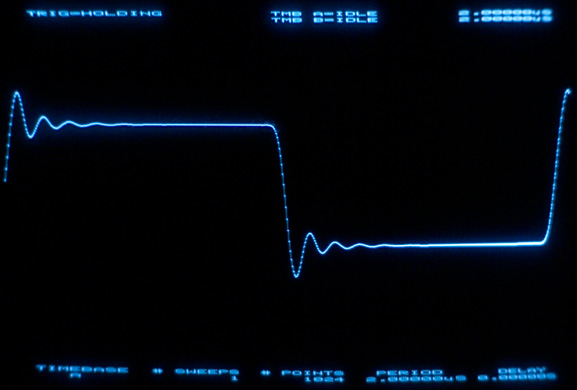
DAC 128fs ADC
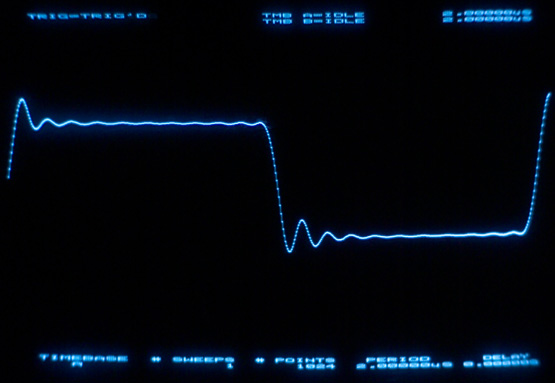
DAC standard ADC
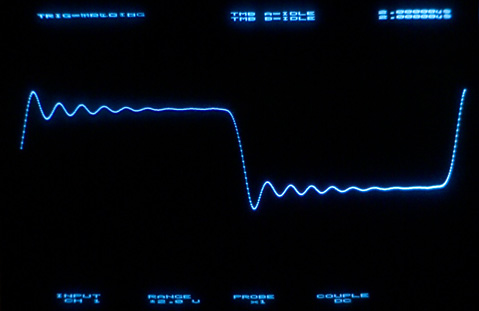
4x os player Audio Precision digitally
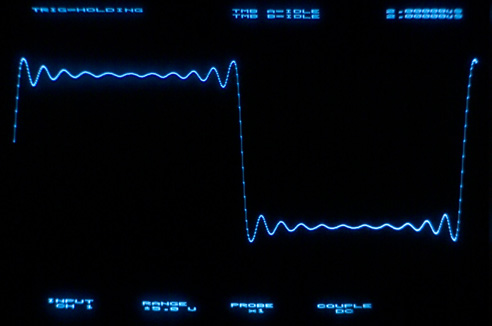
4x os player 128fs ADC
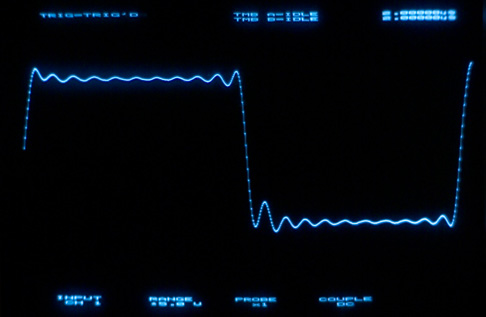
4x os player standard ADC
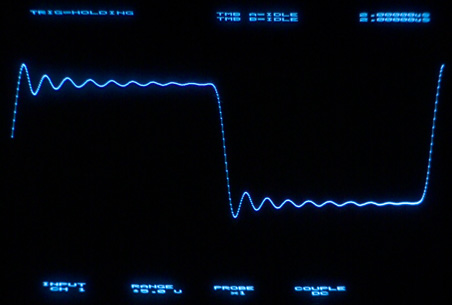
A DVD player looked similar to the 4x os player.
Why does the standard AD converter have no pre-ringing on the os players ? Because the 1002,3 Hz ?
Because the 1002,3 Hz ?
Your simulation is not a analog system ?
As you say that a clean unlimited bandwith square that travels through a analog bandwith limited system will show pre-ringing,
Why my analog filter doesn't ?
Also when I simulate my filter with a analog square, it shows only post-ringing like on a scope.
I did another test with a chesky CD: Square 1002,3 Hz
DAC Audio Precision digitally

DAC 128fs ADC

DAC standard ADC

4x os player Audio Precision digitally

4x os player 128fs ADC

4x os player standard ADC

A DVD player looked similar to the 4x os player.
Why does the standard AD converter have no pre-ringing on the os players ?
Dear tritosine ,
First of all, I do not believe NOS to be the ultimate solution, I am sure one of the solutions out there is better than NOS. That is why I started this thread in the first place. I am a believer in progress in technology, I have Tripath not SETs.
But what bugs me is the criteria they had chosen when they started design the digital filter or DAC. If the criteria had been a 192KHz sample recording which includes voices, various instruments and orchestra etc etc. 1 in 4 of the data point is taken out to create a 44.1 KHz sample. The evaluation of the digital filter will be based on how well it manages to predict the missing 3 points... I would believe that would be a good DAC.
But if a DAC is based on how well it can create a 1KhZ sample, 10KHz and 15KHz sinewave, I have my doubts on that.
A classic example of how wrong things can go if you relied too much of electronic measurement is the first transistor amplifiers with feedback, the quest was on to create even lower and lower THD. The easiest way to do that was to increase open loop gain. Next thing you know all the amps were oscillating and ringing like crazy. BUT they showed great on the THD chart.
Originally I thought that just simple linear interpolation might be okay, but I guess not.
Incidentally who you be able to point me to some info on the ESS. Reviews, even kit sets/prebuilt modules if they are available.
Oon
First of all, I do not believe NOS to be the ultimate solution, I am sure one of the solutions out there is better than NOS. That is why I started this thread in the first place. I am a believer in progress in technology, I have Tripath not SETs.
But what bugs me is the criteria they had chosen when they started design the digital filter or DAC. If the criteria had been a 192KHz sample recording which includes voices, various instruments and orchestra etc etc. 1 in 4 of the data point is taken out to create a 44.1 KHz sample. The evaluation of the digital filter will be based on how well it manages to predict the missing 3 points... I would believe that would be a good DAC.
But if a DAC is based on how well it can create a 1KhZ sample, 10KHz and 15KHz sinewave, I have my doubts on that.
A classic example of how wrong things can go if you relied too much of electronic measurement is the first transistor amplifiers with feedback, the quest was on to create even lower and lower THD. The easiest way to do that was to increase open loop gain. Next thing you know all the amps were oscillating and ringing like crazy. BUT they showed great on the THD chart.
Originally I thought that just simple linear interpolation might be okay, but I guess not.
Incidentally who you be able to point me to some info on the ESS. Reviews, even kit sets/prebuilt modules if they are available.
Oon
oon_the_kid said:Dear tritosine ,
First of all, I do not believe NOS to be the ultimate solution, I am sure one of the solutions out there is better than NOS. That is why I started this thread in the first place. I am a believer in progress in technology, I have Tripath not SETs.
But what bugs me is the criteria they had chosen when they started design the digital filter or DAC. If the criteria had been a 192KHz sample recording which includes voices, various instruments and orchestra etc etc. 1 in 4 of the data point is taken out to create a 44.1 KHz sample. The evaluation of the digital filter will be based on how well it manages to predict the missing 3 points... I would believe that would be a good DAC.
But if a DAC is based on how well it can create a 1KhZ sample, 10KHz and 15KHz sinewave, I have my doubts on that.
A classic example of how wrong things can go if you relied too much of electronic measurement is the first transistor amplifiers with feedback, the quest was on to create even lower and lower THD. The easiest way to do that was to increase open loop gain. Next thing you know all the amps were oscillating and ringing like crazy. BUT they showed great on the THD chart.
Originally I thought that just simple linear interpolation might be okay, but I guess not.
Incidentally who you be able to point me to some info on the ESS. Reviews, even kit sets/prebuilt modules if they are available.
Oon
fair, so if we follow your assumption, a NOS dac can be ok up until 5khz?
Meridian is on the right track with something, I saw it several times, that theres only "crud" above 18-20khz, spurious peaks and stuff, a sure thing that a little phase shift must sound better than if we try and force textbook interpolation at all costs (linear phase "ideal filter" ) , or if we let the spurious peaks to reproduce themselves as alias (NOS route ...), this also comes at a cost, the Meridian squarewave response would be "unnacceptable" to the nos crowd 
Most digital filters sound somehow different, although they are mostly tuned for best compromise on all parameters.
Some manufacturers try to tweak into some direction to achieve a compromise that fits their philosophy, see Meridian.
Others have switchable characteristic to let the customer choose his poison, see Sony.
In any case a digital filter sounds and never sounds right, can we agree about that
If we avoid parts that sound, like opamps, coupling caps, why not avoid the digital filter ?
My analog filter was optimized for amplitude flatness in the pass band & stopp band attenuation, compromise was made on the impulse response and the phase response.
Important is: For lossless digital signal processing, the bit depth in the filter process must be much higher than the final bit depth of the digital data. Interpolation does not help. That means that it might be ok if a recording is 24 bit, the mixing console uses 24 bit, finally it is downsampled to 16 bit for CD.
But filtering 16 bit data and output 16 bit data will reduce resolution, detail is lost.
Analog filters do not have that problem.
That is very easily understood when working with photoshop...
Future solution would be 24 bit 96 kHz non os.
Some manufacturers try to tweak into some direction to achieve a compromise that fits their philosophy, see Meridian.
Others have switchable characteristic to let the customer choose his poison, see Sony.
In any case a digital filter sounds and never sounds right, can we agree about that
If we avoid parts that sound, like opamps, coupling caps, why not avoid the digital filter ?
My analog filter was optimized for amplitude flatness in the pass band & stopp band attenuation, compromise was made on the impulse response and the phase response.
Important is: For lossless digital signal processing, the bit depth in the filter process must be much higher than the final bit depth of the digital data. Interpolation does not help. That means that it might be ok if a recording is 24 bit, the mixing console uses 24 bit, finally it is downsampled to 16 bit for CD.
But filtering 16 bit data and output 16 bit data will reduce resolution, detail is lost.
Analog filters do not have that problem.
That is very easily understood when working with photoshop...
Future solution would be 24 bit 96 kHz non os.
Can anybody read this for me?
http://v3.espacenet.com/publication...=B1&FT=D&date=20020319&DB=EPODOC&locale=en_EP
Awful patent lawyer´s language.
http://v3.espacenet.com/publication...=B1&FT=D&date=20020319&DB=EPODOC&locale=en_EP
Awful patent lawyer´s language.

phofman said:Is there a modern 24/96 DAC without internal oversampling?
Lavry da924 must be one.
BTW you cnt avoid digital filters, its in the data already . With modern software interpolators like the ones they use for decimating 24/96 into 16/44 ,any artifact is pushed below -180 dB, 32 bit DNR..... Also Bernhard, your arrangement can be completely built in digital realm , if you use ZOH function to generate new sample points and apply correction the same way like you do now, with the same filter slope . I wonder wht degree of difference would there be.
The PCM1704 is 24bit 96kHz straight.
Tritosine mentioned that down-sampling from a 24bit/96kHz master to a 16bit/44kHz CD causes ringing. Does this mean that there is now ringing inherent on the CD ? How bad is this ringing compared to say 8x oversampling ?
According to Borbely, the SRC4392 can interpolate without introducing ringing. But SRCs are accused of converting jitter into data and thus often having a signature of their own. Can anyone confirm this ?
How about using an SRC solely for interpolation and feeding it from a low jitter source ?
Tritosine mentioned that down-sampling from a 24bit/96kHz master to a 16bit/44kHz CD causes ringing. Does this mean that there is now ringing inherent on the CD ? How bad is this ringing compared to say 8x oversampling ?
According to Borbely, the SRC4392 can interpolate without introducing ringing. But SRCs are accused of converting jitter into data and thus often having a signature of their own. Can anyone confirm this ?
How about using an SRC solely for interpolation and feeding it from a low jitter source ?
el`Ol said:Can anybody read this for me?
http://v3.espacenet.com/publication...=B1&FT=D&date=20020319&DB=EPODOC&locale=en_EP
Awful patent lawyer´s language.
Parallel A/D converters with shifted sampling points to incrase the sampling rate ?
- Status
- This old topic is closed. If you want to reopen this topic, contact a moderator using the "Report Post" button.
- Home
- Source & Line
- Digital Line Level
- NOS DAC with oversampling - anybody done it?
